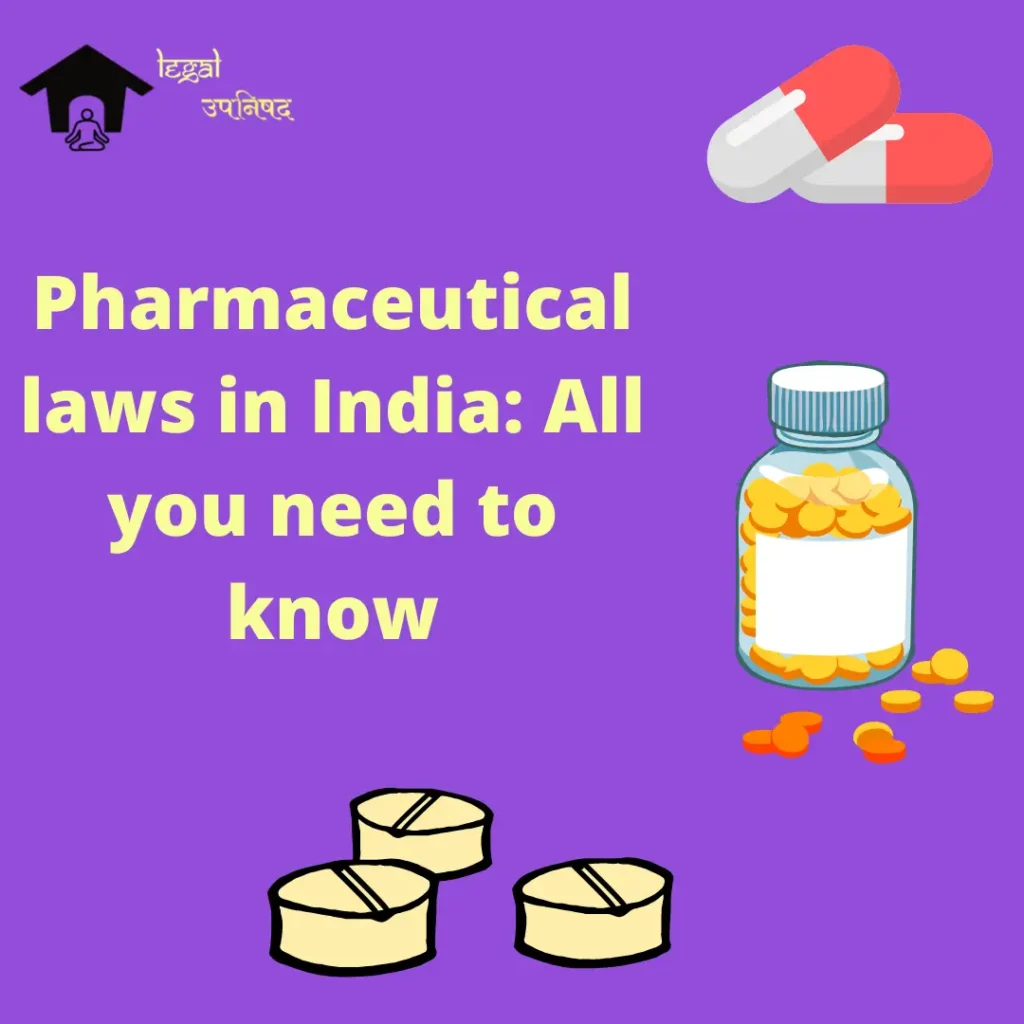

Pharmaceutical is accountable for the discovery, development, removal, secure and efficient use, and regulation of pharmaceuticals and medications at their best use. Pharmaceuticals are the bridge between the Chemistry of the drugs and medical practice. Command in medications along with working mechanisms, health consequences, combinations, and toxicity are prerequisites for practicing pharmacy.
India has a flourishing pharmaceutical and healthcare industry. Enabling the pharmaceutical industry in India, and to take a leadership role in the international market, and ensuring the widespread supply of high-quality, affordable drugs for consumer use, the legislation plays a vital role in that. Therefore, this blooming potential needs to be equipped with laws, thereby, from establishing the councils of pharmacy to regulating the profession of pharmacy.
This article will assist you to understand what pharmaceutical means and what the laws and regulations that regulate the pharmaceutical industries in India.
Pharmaceuticals are the material used to restore, rectify, or improve natural processes as well as diagnose, provide better cures, and thereby reduction of the risk of any disease altogether. For example, sleeping peels, Cyrus, or any other medicine works on the same principles. Pharmaceuticals are often categorized by chemical family, pharmacological activity, and therapeutic application.
A medical professional who has received special training to be an expert in medications is a pharmacist. Their role holds important responsibilities in informing individuals about the dangers of taking medications and teaching them how to properly self-administer them.
On the other hand, To provide novel therapeutics that are reliable and provide the best treatments for sickness, pharmaceutical scientists research medication action and are engaged in the work of drug development. Professional researchers are employed by biotech and pharmaceutical businesses to conduct trials as part of collaborative data analysis to bring novel medicines to the industry.
Up to the graduate level, pharmacy education and profession are regulated by the pharmacy council of India (PCI). The objectives of PCI are:
The International ranking of Indian Pharmaceutical production in terms of volume and value is third and fourteenth respectively. Because of the industry’s capabilities and rising medical standards in the nation, the market pharmacy is continually expanding. The rise of these ranks was witnessed during the period. In such an expansion of the industry, the law sector plays a vital role in that.

The following are some of the important pharmaceutical laws in India:
Earlier there was no restriction on practicing the profession of pharmacy. People who do not have any knowledge or education are found to be engaged in this profession. This was causing damage to society as people were getting bad or inappropriate medications. Hence, The Pharmacy Act, of 1948 was enacted for a well-regulated pharmacy in terms of its practice and profession.
A Central Pharmacy Council of India is established by the Central Government following the terms of this act, and State Pharmacy Councils are under the State Governments.
Indian Legislature approved the Drugs and Cosmetics Act of 1940, which governs the nation’s importation, production, and drug distribution. The main objective of the Act is to make sure that all medications and cosmetics marketed in India are secure, efficient, and up to par with quality regulations.
The related Drugs and Cosmetics Rules, 1945, provide specifications for classifying medications as well as instructions for each category’s maintenance, distribution, presentation, and prescriptions.
Drugs and Magic Remedies (Objectionable Advertisement) Act, 1954 has the following objectives for its enactment:
The Drugs and Magic Remedies Act, of 1954 mentions the list of diseases for which advertisement is banned.
The Narcotic Drugs and Psychotropic Substances Act, 1985 restricts the following actions considering them illegal. These could be harvesting, manufacturing, owning, selling, buying, producing, consuming, and regulating other operations related to narcotic drugs or psychotropic substances of any kind.
This act is for the estimation of any pharmaceutical as well as toiletry foods that contain alcohol, narcotics, or both. The decided Excise taxes are also collected on mentioned items with the provision of this act.
The joint venture of the Department of Pharmaceuticals and the Ministry of Chemicals and Fertilizers aimed for the affordability factor of medicines. Not all medicines could be pushed to attain the lowest charge possible criteria, but several basic medications can be supplied to the market. When the basic medicines are available to the population at an affordable cost, it would lead to the attainment of the national level healthy status of the population. The main reason to enact this act was to provide patients with medicines at an economical price in India.
The Government of India passed the order following Section 3 of the Essential Commodities Act of 1955 for better control and regulation of the cost prices of medicines in the Indian market. The National Pharmaceutical Pricing Authority (NPPA) holds the authority of the Drugs Price Control Act, 2013.
The bodies that regulate the Pharma and healthcare sector in India are:
Through the Department of Health, the Ministry of Health & Family Welfare oversees the healthcare and pharmaceutical industries in the nation. Central Drugs Standard Control Organization (CDSCO) in association with the Drugs Controller General of India (DCGI) is the main organization of the department that regulate the basic issues of health.
Three departments that together make up the Ministry of Chemicals and Fertilizers are dedicated to the development and regulation of chemicals in the country. This trio is:
The Indian pharmaceutical industry is a rising competitor. The records, the Pharma production had made during worldwide phenomena of Corona in past two years led the focus of the world shifting towards India. Pharmaceuticals Industry is all about the curing and treatment of diseases through the process of years of research and development, and thereafter large scale production. This industry also works for immunizing a person to deal with any sort of possible risk of any disease.
The prominent provisions are present in the pharmaceutical industries for the proper regulation of the pharmacy and healthcare sectors. Several laws are provided to the pharmaceutical industries for bona fide functioning and providing the best medication and health care services to the citizen of India.

Our Latest Articles
Divorce is rarely simple, however when huge resources, high-profile people, or complex relational intricacies are involved, the stakes are considerably higher. High-stakes divorce from cases require a degree of mastery and key reasoning that goes past the conventional. In Chennai, divorce from expert legal advisors is exceptional to deal with these difficult cases, guaranteeing that their clients’ advantages are safeguarded constantly. This is the way top divorce lawyers in Chennai explore the intricacies of high-stakes divorces. Far reaching Case Investigation The most vital phase in dealing with a high-stakes divorce is an exhaustive examination of the case. Divorce from expert… Read more : How Divorce Specialist Lawyers Handle High-Stakes Cases?
Article title: ‘PCI Hosting: A Cornerstone of Data Privacy Compliance’ Introduction The Payment Card Industry Data Security Standard (PCI DSS) is a crucial framework designed to protect sensitive cardholder data and ensure secure transactions. As data breaches become increasingly common, and global data privacy regulations such as GDPR, CCPA, and HIPAA tighten their grip, maintaining compliance with these standards has never been more vital. PCI hosting emerges as a pivotal solution, enabling organizations to align with these stringent regulations, safeguard customer data, and fortify their security posture. Understanding PCI DSS PCI DSS is a set of security standards created to… Read more : PCI Hosting: A Cornerstone of Data Privacy Compliance
Selecting the best criminal lawyer requires assessing a number of important factors. The choice of criminal defense attorney can make all the difference in how a case turns out. With the significant risks involved, having an informed and skilled lawyer at your side can really pay off. The right attorney from the list of criminal lawyers in bangalore will help their client navigate the complexities of the criminal justice system by recognizing legal nuances and offering strong defense tactics. Good Reputation and Professionalism A lawyer’s reputation and professionalism are crucial indicators of their reliability. Seek out an attorney known for… Read more : What To Look For In A Criminal Lawyer? Check Here
This article on ‘New Hit and Run Law in India: Understanding the Controversy and Protests’ was written by Tosani Lal, an intern at Legal Upanishad. I. INTRODUCTION Hit and run refers to the act of a driver causing an accident and fleeing the scene without providing assistance or identifying themselves.[1] The action is widely condemned due to its potentially severe consequences for victims and the lack of accountability it entails. Hit and run incidents often result in serious injuries or fatalities, leaving victims and their families devastated. The new hit and run law in India, implemented under the Bharatiya Nyaya Sanhita,… Read more : New Hit and Run Law in India: Understanding the Controversy and Protests
In this article, we will delve into the recent landmark ruling by the Supreme Court of India in the case of Association for Democratic Reforms v. Union of India.
May we help you?